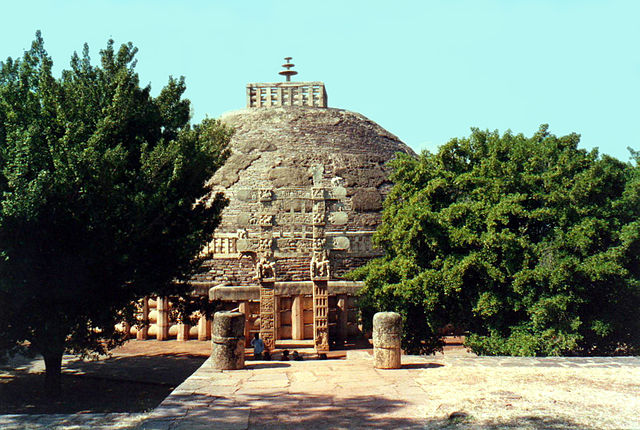
Sanchi
Madhya Pradesh, India
Site Map (1)
The Principal Monuments (12)
Plan and Elevation of Stupa 1 (1)
Stupa 1 East Gate (11)
Stupa 1 South Gate (3)
Stupa 1 West Gate (7)
Stupa 1 North Gate (8)

|
SanchiMadhya Pradesh, India Site Map (1)
|
Although not directly connected with events in the life of the Buddha, Sanchi became a pilgrimage site when Ashoka Maurya erected a stupa and column there in the middle of the 3d century BC. Later rulers enlarged the complex. After the decline of Buddhism in India, the ruins lay neglected until the 19th century, when they were despoiled by treasure hunters. Restoration activity commenced in the early 20th century, with the rebuilding of the principal stupas and the creation of the present park and museum. Sanchi is a UNESCO World Heritage Site.
The earliest stupas predated Buddhism and were simple funerary mounds that held the ashes of the deceased. Built of earth, they have not survived. Buddhist stupas developed as reliquary mounds, holding the divided ashes of Buddha himself, or of later Buddhist teachers. However, many stupas contain only symbolic objects rather than actual remains. The dome is filled with rubble, covered by a masonry exterior, and topped by a squared-off platform (harmika) that encloses a royal parasol (chattra) atop a mast (yasti). In its full development, the dome is placed atop an elevated platform with stairs leading clockwise from the ground level up to a circular walkway, where the worshipper may circumambulate the dome. Finally, the whole stupa is enclosed by a railing (vedika) and elaborate gates (torana) are built in front of each of the four cardinal points. The forms of the staircase, gates, harmika, and so on are imitative of wooden structures. The harmika and associated structures are derived from the chaitya - an early tree-shrine, surrounded by a fence. All these features can be seen in Stupa 1 at Sanchi, the earliest and best surviving example of this kind of building.
The stupa undergoes a long development following this early history, transforming ultimately into the dagoba (Sri Lanka), chorten (Tibet), wat (SE Asia), and pagoda (China, Japan).
Symbolism of the stupa relates first of all to directionality and the cosmos. Stupas are built on a hill, where their beneficial influence can radiate to all four points of the compass. The dome represents the universe, also (as in later Hindu temples) a world-mountain whose axis is defined by the mast, and finally the
symbolic body of Buddha himself, decorated (on gates and railings only) with sculpted scenes from his life and Jataka stories of his previous incarnations.

|